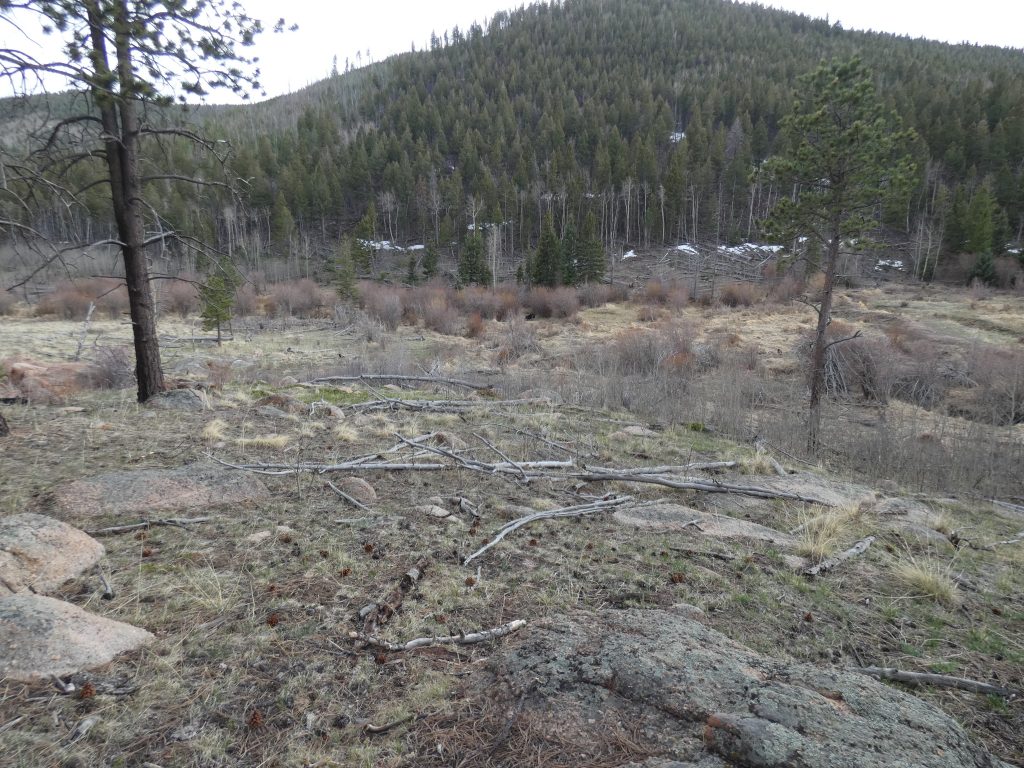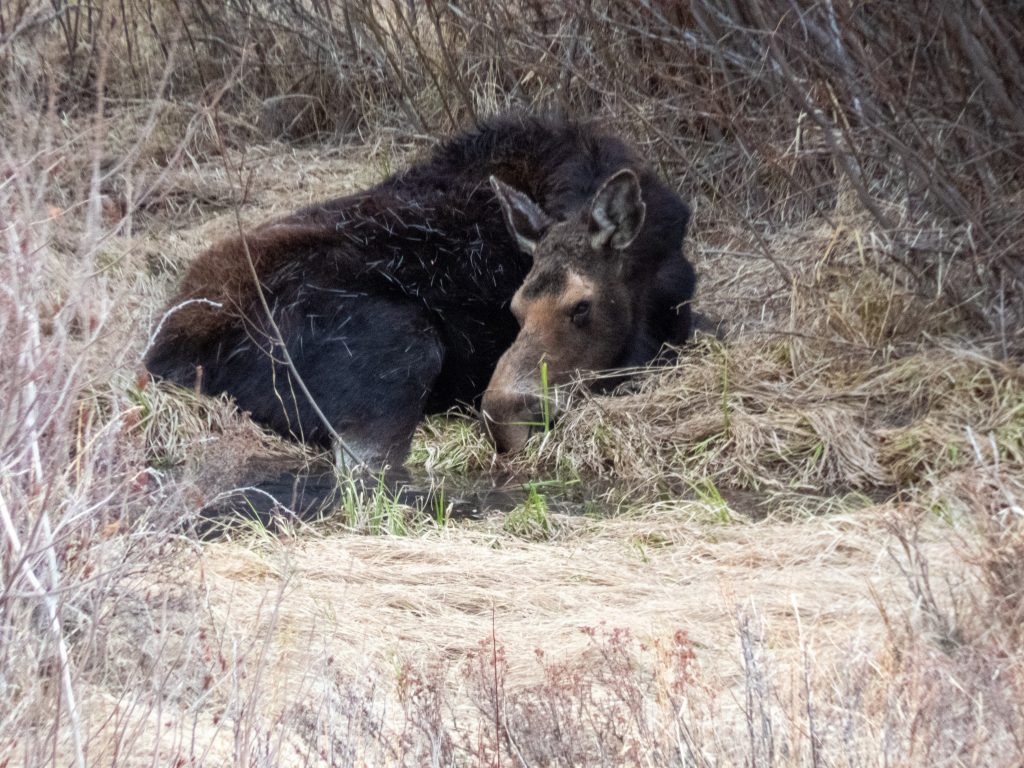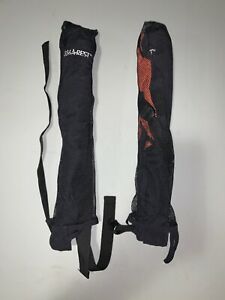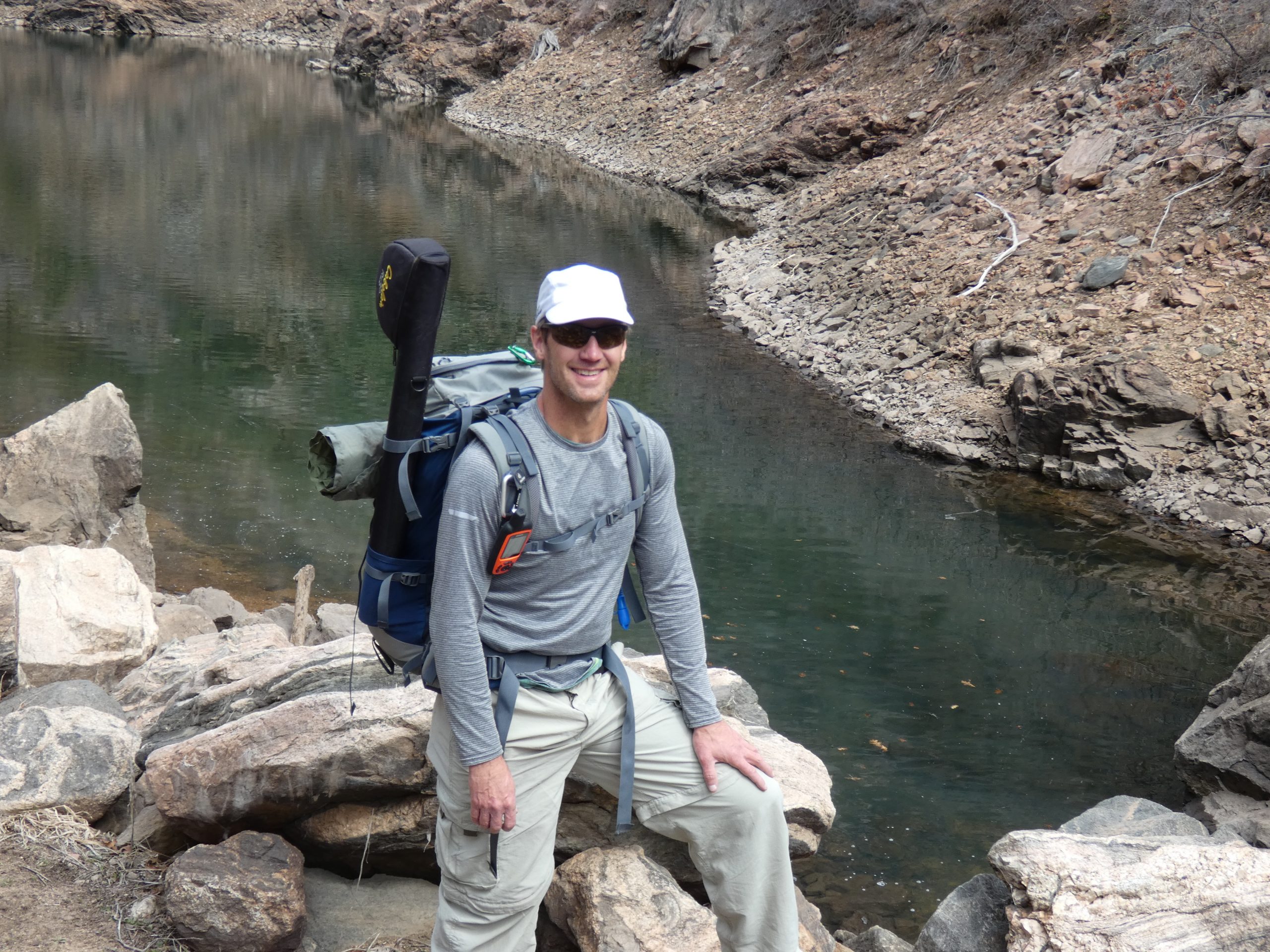Spring has provided a few backpacking trips in Colorado already (see Lost Creek Wilderness and Indian Creek). This week I had a little time so I thought I’d inventory and share my current backpacking gear setup. My backpacking gear isn’t an “ultralight” configuration although I think it provides a reasonable tradeoff of weight and functionality. The pack usually weighs in around 32 lbs. with 4 days of food and 3 liters of water.
I focus my backpacking gear for 3 season use in Colorado. Winter snowshoeing or backpacking requires a significantly different set of clothes and gear. Most of the seasons, I’m backpacking in shorts and a t-shirt because of the warm, clear weather we enjoy in Colorado. We have a monsoon season so afternoon showers can be common in the summer months. Most storms are short, but intense. The nights can be cooler or cold at higher altitudes. This equipment has worked for me in these conditions with temperatures ranging from the 20’s to summer heat.
There are always improvements to be made, so feel free to make suggestions in the comments or by contacting me. I’d love to give alternatives a try!
Hiking Boots
My Lowa Renegade GTX boots are about 6 years old and were not as expensive when I bought them as they are today. These boots are relatively light in weight yet have all the protection for my ankles and feet that I need while hiking.
My first trip this year resulted in some tired feet so I’ve replaced the insoles with Oboz Insoles. The replacements were a huge improvement on my last trip. These shoes work well for me on the variety of trails in Colorado.
Sometime this year I may use my day hiking shoes instead of boots just to try them out backpacking. My Saucony Men’s Peregrine Trail Runners are very comfortable, even on longer hikes of 13+ miles. The reason I’ve hesitated is the ankle protection and support provided by the Renegades. Now that I think of it, maybe I won’t try them out. 😉
Clothing
Hiking Pants – For several years I had a cheap pair of convertible pants I’d picked up from Big 5. I’d never been happy with them as they were too long and the material didn’t breathe well. Still, I’m really cheap, so it took me until this year to get a better pair. Based entirely on a recommendation from the Hiking Guy, I purchased a pair of prAna convertible pants. So far I love these pants! They are water resistant, stretchy, cool, and very comfortable. The material is much better than the cheapo ones I had before.
Hiking base layer shirt – My hiking shirts come from REI. There are two styles I own, one that is 100% Polyester and one that is 95% Polyester and 5% Spandex. Both styles serve me well in a variety of conditions and last a long time. Most of the shirts REI sells now are 92% Polyester and 8% Spandex. The Sahara or On The Trail Run t-shirts are good options.
Light Middle Layer – Hiking in the mountains requires many layers. There are lots of times I need a simple, lightweight layer over my t-shirt just to take the edge off the cool temps or get some sun protection. I use a Champion C9 Running shirt I received as a gift from Tanya. She picked it up at Target. I’ve had a tough time tracking down more of them since Target doesn’t sell them anymore. Amazon appears to have a newer version, the Champion C9 Tech Tee, I’ve yet to try out. Hopefully it is the same one as I love this shirt!
Heavier Middle Layer – Six+ years ago I purchased a mid-weight base layer that, despite the categorization of “base layer”, I’ve worn many times as a pullover. It keeps me warm during those cold mornings and nights at camp. The current version looks like it would work the same.
Outer Layer – The North Face outer layer I have is so old I can’t even find it on the internet anymore. Say what you want, but it isn’t like these things wear out! It is a fully waterproof shell with vents. REI offers a Windstopper although I’d recommend the the XeroDry GTX Jacket instead because it is a waterproof shell. Rain during the summer monsoon season can be intense even if short-lived as Edwin, Bryson and I have experienced in the Mt. Evans Wilderness. A waterproof shell saves the day in those situations.
Early or late in the season, I take a set of light gloves with me. Costco sells Head gloves that I use for running, hiking and backpacking. They are usually available in the store at $10/pair or less.
Backpack
My first pack was a canvas inner-frame beast from over 30 years ago. Luckily, I’ve updated this piece of equipment! There have been many packs that have come and gone. My current pack is the Deuter 65+10 Hiking Backpack, Arctic/Granite. I’ve had this backpack for several years and love the comfort and weight of the pack.
The pack is easy to adjust with Deuter’s Vari-Quick adjustment system. The pack fits well on my body and the weight settles perfectly on my hips. Even with my back issues, I’ve never had problems hauling this pack around.
It’s worthwhile to get the rain cover as it keeps the pack dry in those unexpected rainstorms!
Tent
For the past 8 years, I used my Nemo Nano Elite single-wall tent. It was lightweight and roomy by two person tent standards. The tent wasn’t easy to set up but easily handled many storms. My Nano eventually hit its end of life and started falling apart. No complaints, I got my use out of it and it served me very well in a variety of conditions.
The tent I have now is the Nemo Hornet 2P. After a few outings I’ve been happy with it. It isn’t as roomy as the Nemo Nano although I haven’t found a two-person tent that is. It works for me as a one person tent and weighs about 2lbs, 6ozs in my pack. The Hornet 2P is light and easy to set up, much easier than the Nano. I bought the Nemo Footprint for it because the material is very lightweight.
My kids own a few REI tents that are well made and popular items for hikers so I wouldn’t knock those options. Personally, I like the lighter weight and design of Nemo tents.
Sleeping Bag and accessories
For me, a good sleeping bag is one of the most important pieces of backpacking gear. When I expect temps above 35 or so, I take my REI Sub Kilo 20 bag. This bag has been one of my favorite items in my backpacking gear. It has kept me surprisingly warm during moderate cold spells and is extremely light. The compressibility is amazing. It isn’t a true 20 degree bag and is somewhat slim in width, both of which are fine for me. You can tell by the link above that it is discontinued so I’m not sure what I’ll do when it eventually has to be replaced. REI Igneo 25 might be the closest one to it although I don’t have experience with that particular bag.
On colder outings, I use my son’s REI Mojave 15. This bag, while slightly heavier and less compressible, has kept me warm down to around 20. It does tend to decorate the tent with down feathers now and then, although I don’t mind.
Next to a good bag, a comfortable and lightweight sleeping pad is important for me, more so as I’ve gotten older. Hard to believe when I was young I didn’t care about this critical component! One year, for a birthday, my family gave me a Therm-A-Rest Trail Pro knowing I’d be too cheap to get one myself. It’s turned out to be a great pad. It adds comfort when inflated, keeps me warmer due to its 4.0 R-value and compresses well when strapped to my pack. Apparently things always get better, though, since now they have a self-inflating one with a 4.4 R-value. I’ll stick with my current one just the same.
Sleeping on the ground doesn’t get easier as you age. I used to wad up my jacket or some other item for a pillow. Then I bought an inflatable pillow and never looked back. The one I use now is the TREKOLOGY Ultralight Inflatable Camping Travel Pillow. It’s a bargain at $15. The pillow saves my neck and back while out on the trail. I feel spoiled. 🙂
Cooking Gear
Some ultralight backpackers may forgo cooking gear and take ready to eat meals. Personally, I enjoy a hot dinner, sometimes with tea, and certainly must have hot coffee in the morning. Clearly, I bring along cooking gear!
My GSI Pinnacle Dualist kit is very utilitarian. It’s not the lightest item in my pack and there may be better solutions. I like the compact design that allows me to put my camp stove inside the mugs/bowls. Everything is well thought-out, from the measuring graduations on the pot to a strainer built into the lid. The bag is handy to haul water and wash up items as needed. Everything in the kit is useful for me so I’ve stuck with it over the years.
Another necessary backpacking gear item is a light cookstove. There are a lot of options out there. You’ll probably begin to wonder why you’re reading this when I tell you another item I use isn’t available online anymore…wait, you were probably wondering that a long time ago. Sure, some of my equipment is old but it works reliably!
My main stove is an older Primus equivalent of the MSR PocketRocket 2. It still gets the job done and is my most frequently used stove. The compressed gas cookstove is nice for its convenience and simplicity of use although I wish there was a way to tell how much gas was left in a canister! I use these lower cost (i.e. cheap) canisters rather than paying more for the MSR or JetBoil brands.
My other stove, an MSR WhisperLite, is even older at close to 30 years. The design has not changed during those 30 years. The white gas MSR WhisperLite requires a little more work than the Primus, but is more reliable at cold temps and is a fast cooker. An few added pluses, a full white gas canister will last a long time and you can look in it to see how much fuel is left.
With all that said, the compressed gas cookstove is what I use most. I carry a Sharpie in my pack and put a mark on the canister for every 16 ounces of water boiled. It isn’t exact, but it gives me an idea of how much fuel is left.
Water Purifier
As I mentioned in my opening, I typically have about 3 liters of water with me. That won’t get you very far in the dry climate of Colorado, especially if you huff, puff and sweat as much as me! A water purifier is important if you want to keep that water load down.
There are a lot of different options for water purifiers. The First Need XL kit is my preferred purifier. It’s a little heavier than some options out there. I’m ok with carrying a little more weight to spend less time purifying water. The time to fill a Nalgene bottle is pretty short, and the purifier removes all the nasties I need it to. Every now and then I’ll test the filter at home using a blue food dye test to make sure all is well.
GPS
This year I picked up the Garmin Explorer+ to provide GPS logging for pictures and to assist with navigation. The inReach device has been a great addition. I’ve already used it several times to bushwhack in the wilderness this year. Each time is has been invaluable on getting me back on track.
Camera
Many people use their phones or a small point-and-shoot camera out on the trail. After going through an extensive amount of research, I upgraded my camera to the Panasonic FZ80 this year. It’s allowed me to capture some amazing wildlife shots that would have been impossible without a superzoom. The two pictures below speak for themselves. I take it on every outing.


Miscellaneous
There are a few other items I tote along as part of my backpacking gear including rope, repair kit, saw, battery pack light, moleskin, and a chair. My repair kit consists mainly of black electrical tape and a few small hose clamps. Paracord works well for emergencies and hanging my food in the bear bag.
The backpacking saw I have is a Sven Saw. The saw goes with me less and less since most of the summer has fire restrictions in the backcountry. The saw, however, is great for cutting up some of the larger dead wood that can be found backpacking.
Another luxury item of backpacking gear is my Therm-A-Rest Trekker Chair. I don’t know why they don’t make it anymore. Mine looks like the chair in the picture below and is very lightweight. It gives me good back support when in camp and that’s a necessity for me these days.

This year I added a small Hybridlight Solar Rechargeable PUC 150 to my pack. The light is very versatile as it acts as a flashlight, tent light, camp lantern, and a rechargeable boost for USB devices (e.g. my iPhone or GPS). It’s another 2020 small addition that I’ve been happy carrying as part of my backpacking gear.
Summary
Hopefully you’ve found this listing of gear helpful. Again, feel free to make recommendations or suggestions via comments or by contacting me.
